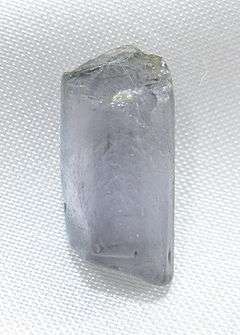Sillimanite
| Sillimanite | |
|---|---|
|
Lustrous crystals of sillimanite (to 3 cm) embedded in schist matrix from Norwich, New London County, Connecticut | |
| General | |
| Category | Nesosilicate |
| Formula (repeating unit) | Al2SiO5 |
| Strunz classification | 9.AF.05 |
| Dana classification | 52.02.02a.01 |
| Crystal system | Orthorhombic |
| Crystal class |
Dipyramidal (mmm) H-M symbol: (2/m 2/m 2/m) |
| Space group | Pbnm |
| Unit cell |
a = 7.47 Å, b = 7.66 Å c = 5.75 Å; Z = 4 |
| Identification | |
| Color | Colourless or white to grey, also brown, yellow, yellow-green, grey-green, blue-green, blue; colourless in thin section |
| Crystal habit | Prismatic crystals, fibrous, acicular |
| Cleavage | {010} perfect |
| Fracture | Splintery |
| Tenacity | Tough |
| Mohs scale hardness | 7 |
| Luster | Vitreous to subadamantine, silky |
| Streak | White |
| Diaphaneity | Transparent to translucent |
| Specific gravity | 3.24 |
| Optical properties | Biaxial (+) |
| Refractive index | nα = 1.653 - 1.661 nβ = 1.654 - 1.670 nγ = 1.669 - 1.684 |
| Birefringence | δ = 0.020 - 0.022 |
| Pleochroism | Colourless to pale brown to yellow |
| 2V angle | 21 - 30° |
| References | [1][2][3][4] |
Sillimanite is an alumino-silicate mineral with the chemical formula Al2SiO5. Sillimanite is named after the American chemist Benjamin Silliman (1779–1864). It was first described in 1824 for an occurrence in Chester, Middlesex County, Connecticut, US.[3]
Occurrence

Sillimanite is one of three aluminosilicate polymorphs, the other two being andalusite and kyanite. A common variety of sillimanite is known as fibrolite, so named because the mineral appears like a bunch of fibres twisted together when viewed in thin section or even by the naked eye. Both the fibrous and traditional forms of sillimanite are common in metamorphosed sedimentary rocks. It is an index mineral indicating high temperature but variable pressure. Example rocks include gneiss and granulite. It occurs with andalusite, kyanite, potassium feldspar, almandine, cordierite, biotite and quartz in schist, gneiss, hornfels and also rarely in pegmatites.[2]
Sillimanite has been found in Brandywine Springs, New Castle County, Delaware, US. It was named by the State Legislature in 1977 as the state mineral of Delaware by suggestion of the Delaware Mineralogical Society, Inc.[7]
Natural sillimanite rocks cut into the required shape and size are used mainly in glass industries. Sillimanite is the best raw material for the manufacture of high alumina refractories or 55-60% alumina bricks. But its use on large scale is not possible due to its fine grading and high cost. Dumortierite and mullite are similar mineral species found in porcelain.[8]
See also
References
- ↑ "WebMineral entry". Retrieved 2009-12-19.
- 1 2 http://rruff.geo.arizona.edu/doclib/hom/sillimanite.pdf Handbook of Mineralogy
- 1 2 http://www.mindat.org/min-3662.html Mindat.org
- ↑ MacKenzie, W. S.; Guilford, C. (1980). Atlas of rock-forming minerals in thin section. Essex: Longman Scientific & Technical. p. 10. ISBN 0-582-45591-X.
- ↑ Whitney, D.L. (2002), "Coexisting andalusite, kyanite, and sillimanite: Sequential formation of three Al2SiO5 polymorphs during progressive metamorphism near the triple point, Sivrihisar, Turkey", American Mineralogist, 87 (4): 405–416
- ↑ Whitney, D.L. (2002), "Coexisting andalusite, kyanite, and sillimanite: Sequential formation of three Al2SiO5 polymorphs during progressive metamorphism near the triple point, Sivrihisar, Turkey", American Mineralogist, 87 (4): 405–416
- ↑ http://www.dgs.udel.edu/Geology/Mineralogy/destatemineral.aspx Delaware State Mineral, Sillimanite, Delaware Geological Survey
- ↑ Klein, Cornelis and Cornelius S. Hurlbut, Jr., Manual of Mineralogy, 1985, Wiley 20th ed., p. 380 ISBN 0-471-80580-7

